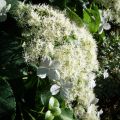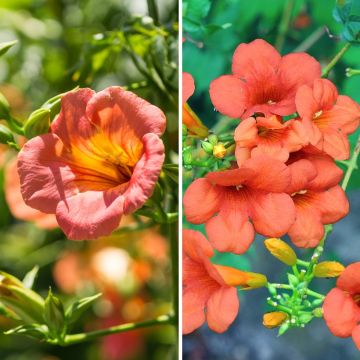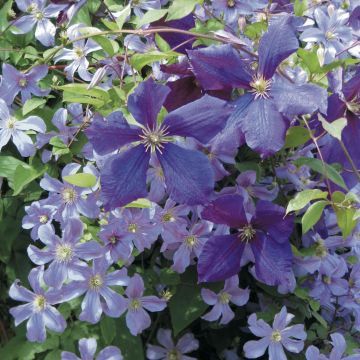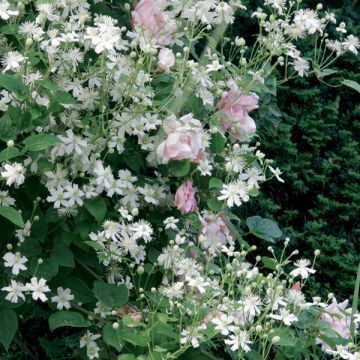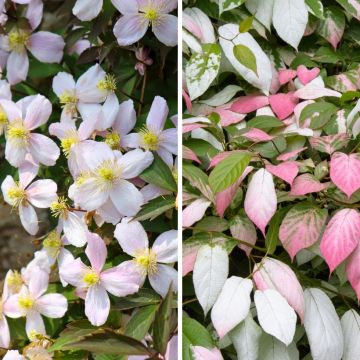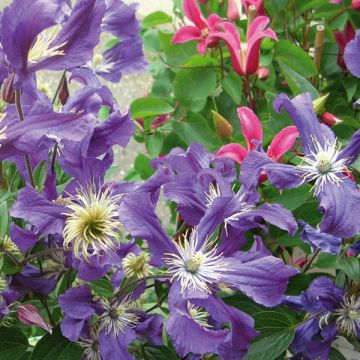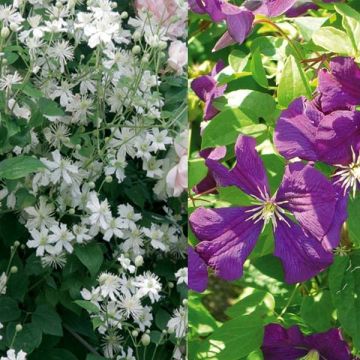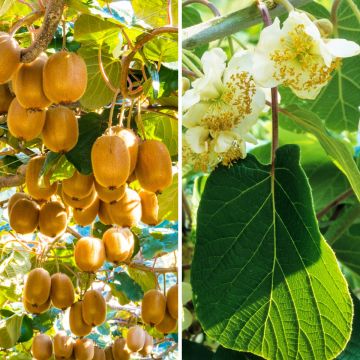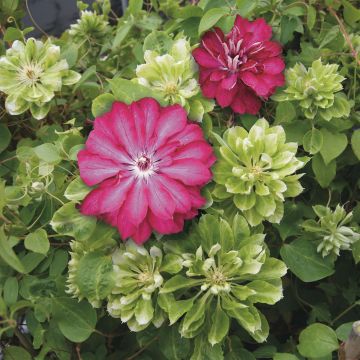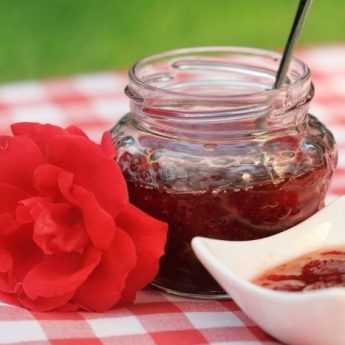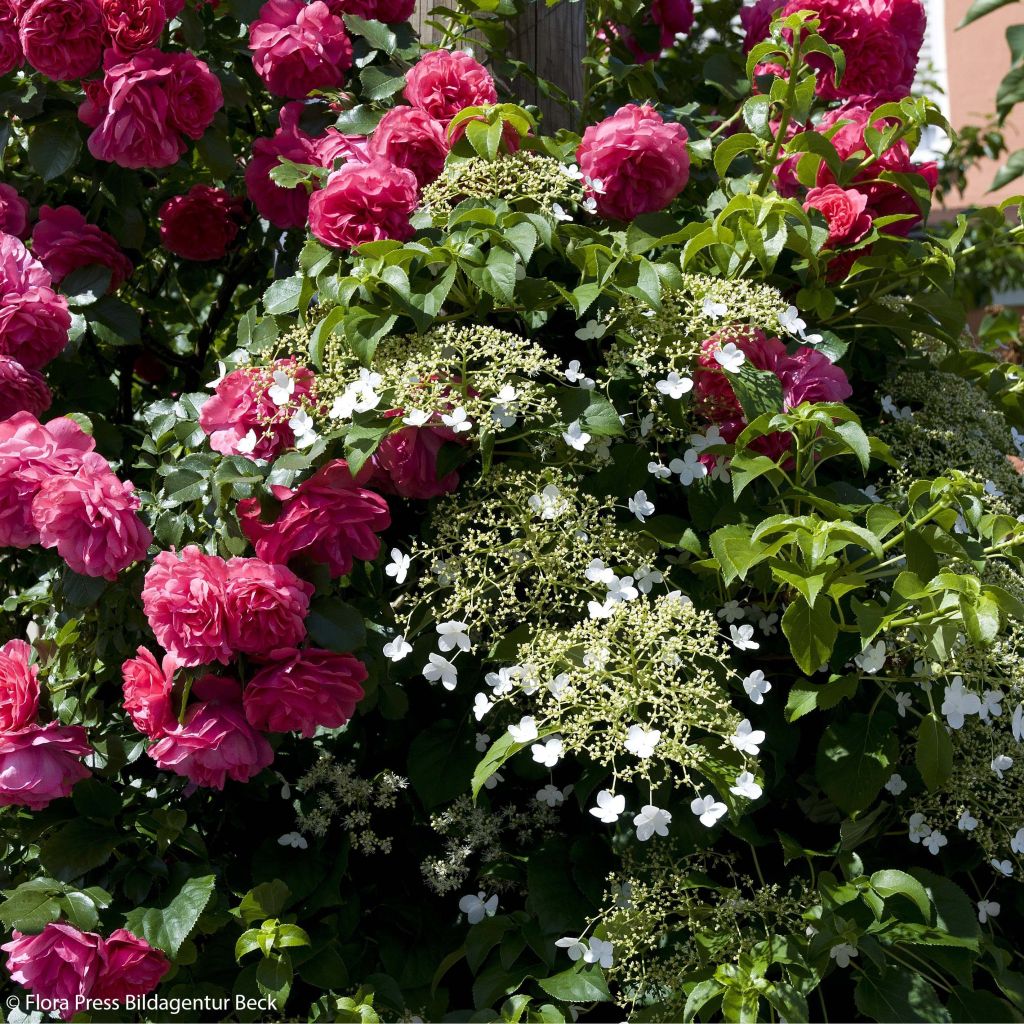

Lace Duo - Laguna Rose + Petiolaris Hydrangea
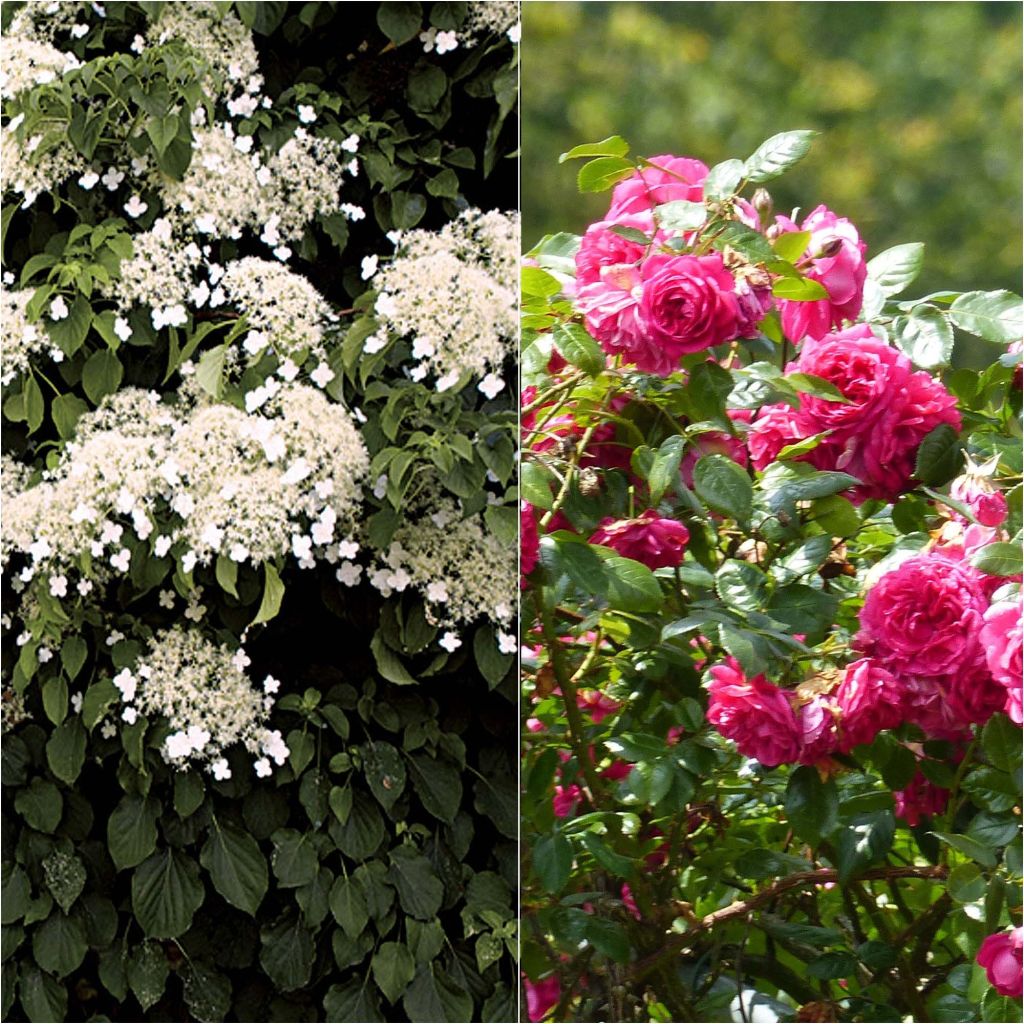

Lace Duo - Laguna Rose + Petiolaris Hydrangea
Lace Duo - Laguna Rose + Petiolaris Hydrangea
This plant carries a 6 months recovery warranty
More information
We guarantee the quality of our plants for a full growing cycle, and will replace at our expense any plant that fails to recover under normal climatic and planting conditions.
Does this plant fit my garden?
Set up your Plantfit profile →
Collection items (2 plants)
Description
Here is a duo of complementary climbing plants, to be placed on a fence, an old tree, a wall, a cabin or any unsightly structure that it will transform: the beautiful old-fashioned roses bloom among the white lace flowers of the climbing hydrangea in the heart of summer. The spectacle continues until autumn, with the rose still flowering among the umbels of its companion, which have turned green and brown. Give your garden a romantic and unusual decoration for many weeks by combining these two worry-free climbers! We recommend planting this duo in separate planting holes, in the morning sun.
This duo consists of a climbing rose Laguna 'Koradigel' and a Hydrangea petiolaris plant.
- The Climbing Rose Laguna is part of a line of roses developed in Germany by Kordes, in search of disease-resistant varieties that combine the floribundance of modern roses with the charm and fragrance of old roses. This rose, full of qualities, received the very demanding A.D.R label in 2007, guaranteeing excellent health, but it also stands out for the delicious fruity scent of its very double 10 cm (4in) flowers, in a deep pink. They bloom in generous bouquets for 4 to 5 months, in successive waves, on vegetation that climbs to a height of 2.50 m (8ft) or 3 m (10ft). The deciduous foliage falls in autumn.
- The Hydrangea petiolaris climbs up to 4 m (13ft) in height and covers an area of almost the same size. This vine develops stems with a very interesting architecture: with age, they crack and their bark peels off in spectacular flakes, giving the plant an attractive appearance even in winter. As a climbing shrub, it clings to its support with climbing roots. Its growth is a bit sluggish in the juvenile stage. It blooms in June-July, even in the shade. Its nectar-filled flowers, in large umbels sometimes reaching 20 cm (8in) in diameter, are flat and white, with a light but sweet fragrance. They transform this shrub into an airy mass. They do not fade but dry slowly on the plant, adopting subtle green nuances before turning brown. Its foliage takes on a lovely golden hue in autumn. It is not an ericaceous plant, and its hardiness can exceed -20°C (1°F). The foliage falls in autumn.
Plant this unusual duo near an old tree, at the foot of an east or southeast-facing wall, to beautify a small structure or a large chicken coop, until autumn. You will amaze your visitors. Take advantage of the ease of cultivation of these two climbers, which require little maintenance, to give your garden a chic and romantic touch. In a few years, they form a very successful marriage in the garden. To their undeniable charm, you could add, if space allows, the delicately variegated foliage of the Gloire de Marengo ivy, which would dress their naked vegetation in winter.
Report an error about the product description
Lace Duo - Laguna Rose + Petiolaris Hydrangea in pictures


Plant habit
Flowering
Foliage
Botanical data
Cultivar or hybrid
Other Climber pairs
View all →Planting and care
For the rose:
Plant the Laguna rose from November to March, in ordinary, well-prepared, and well-drained soil. Roses prefer clayey soils that are rather heavy rather than light. In soil that is too sandy, compacted, or dry in summer, it is preferable to incorporate potting soil, decomposed manure, or compost at the bottom of the planting hole. However, this rose dreads waterlogged soils in winter. Install it about 20 cm (8in) away from its support, in a sunny location, or at most in partial shade in the morning sun. Roses are demanding plants, and a specific fertilizer application will be beneficial for the start of vegetation, and regularly during the entire flowering period.
For the climbing hydrangea:
At planting, install it in a north or east-facing location, not in direct sunlight, in deeply worked, humus-rich soil without excessive limestone. If you plant them in an east-facing location, remember to water regularly in the first few years as the plant will generally receive little water. A good basal fertiliser (bone or dehydrated blood) will promote the growth of your plant and nourish it without the risk of burning. If your soil tends to be dry, incorporate a little compost and mix our water retainer, Stockosorb, with the soil when filling the planting hole, and provide a watering basin on the surface. You can mulch the base in summer to keep the roots cool, and water regularly if the summer is very dry. After a few years, this plant should be able to manage on its own.
To save space, you can plant them in the same hole, which should be of ample dimensions: dig a pit at least 80 cm (32in) wide and 50 cm (20in) deep. Fill it in with a mixture of garden soil and compost. Consider choosing a location where the base of the plants will be shaded, primarily to meet the needs of the climbing hydrangea.
Planting period
Intended location
Care
Planting & care advice
This item has not been reviewed yet - be the first to leave a review about it.
Haven't found what you were looking for?
Hardiness is the lowest winter temperature a plant can endure without suffering serious damage or even dying. However, hardiness is affected by location (a sheltered area, such as a patio), protection (winter cover) and soil type (hardiness is improved by well-drained soil).

Photo Sharing Terms & Conditions
In order to encourage gardeners to interact and share their experiences, Promesse de fleurs offers various media enabling content to be uploaded onto its Site - in particular via the ‘Photo sharing’ module.
The User agrees to refrain from:
- Posting any content that is illegal, prejudicial, insulting, racist, inciteful to hatred, revisionist, contrary to public decency, that infringes on privacy or on the privacy rights of third parties, in particular the publicity rights of persons and goods, intellectual property rights, or the right to privacy.
- Submitting content on behalf of a third party;
- Impersonate the identity of a third party and/or publish any personal information about a third party;
In general, the User undertakes to refrain from any unethical behaviour.
All Content (in particular text, comments, files, images, photos, videos, creative works, etc.), which may be subject to property or intellectual property rights, image or other private rights, shall remain the property of the User, subject to the limited rights granted by the terms of the licence granted by Promesse de fleurs as stated below. Users are at liberty to publish or not to publish such Content on the Site, notably via the ‘Photo Sharing’ facility, and accept that this Content shall be made public and freely accessible, notably on the Internet.
Users further acknowledge, undertake to have ,and guarantee that they hold all necessary rights and permissions to publish such material on the Site, in particular with regard to the legislation in force pertaining to any privacy, property, intellectual property, image, or contractual rights, or rights of any other nature. By publishing such Content on the Site, Users acknowledge accepting full liability as publishers of the Content within the meaning of the law, and grant Promesse de fleurs, free of charge, an inclusive, worldwide licence for the said Content for the entire duration of its publication, including all reproduction, representation, up/downloading, displaying, performing, transmission, and storage rights.
Users also grant permission for their name to be linked to the Content and accept that this link may not always be made available.
By engaging in posting material, Users consent to their Content becoming automatically accessible on the Internet, in particular on other sites and/or blogs and/or web pages of the Promesse de fleurs site, including in particular social pages and the Promesse de fleurs catalogue.
Users may secure the removal of entrusted content free of charge by issuing a simple request via our contact form.
The flowering period indicated on our website applies to countries and regions located in USDA zone 8 (France, the United Kingdom, Ireland, the Netherlands, etc.)
It will vary according to where you live:
- In zones 9 to 10 (Italy, Spain, Greece, etc.), flowering will occur about 2 to 4 weeks earlier.
- In zones 6 to 7 (Germany, Poland, Slovenia, and lower mountainous regions), flowering will be delayed by 2 to 3 weeks.
- In zone 5 (Central Europe, Scandinavia), blooming will be delayed by 3 to 5 weeks.
In temperate climates, pruning of spring-flowering shrubs (forsythia, spireas, etc.) should be done just after flowering.
Pruning of summer-flowering shrubs (Indian Lilac, Perovskia, etc.) can be done in winter or spring.
In cold regions as well as with frost-sensitive plants, avoid pruning too early when severe frosts may still occur.
The planting period indicated on our website applies to countries and regions located in USDA zone 8 (France, United Kingdom, Ireland, Netherlands).
It will vary according to where you live:
- In Mediterranean zones (Marseille, Madrid, Milan, etc.), autumn and winter are the best planting periods.
- In continental zones (Strasbourg, Munich, Vienna, etc.), delay planting by 2 to 3 weeks in spring and bring it forward by 2 to 4 weeks in autumn.
- In mountainous regions (the Alps, Pyrenees, Carpathians, etc.), it is best to plant in late spring (May-June) or late summer (August-September).
The harvesting period indicated on our website applies to countries and regions in USDA zone 8 (France, England, Ireland, the Netherlands).
In colder areas (Scandinavia, Poland, Austria...) fruit and vegetable harvests are likely to be delayed by 3-4 weeks.
In warmer areas (Italy, Spain, Greece, etc.), harvesting will probably take place earlier, depending on weather conditions.
The sowing periods indicated on our website apply to countries and regions within USDA Zone 8 (France, UK, Ireland, Netherlands).
In colder areas (Scandinavia, Poland, Austria...), delay any outdoor sowing by 3-4 weeks, or sow under glass.
In warmer climes (Italy, Spain, Greece, etc.), bring outdoor sowing forward by a few weeks.




































